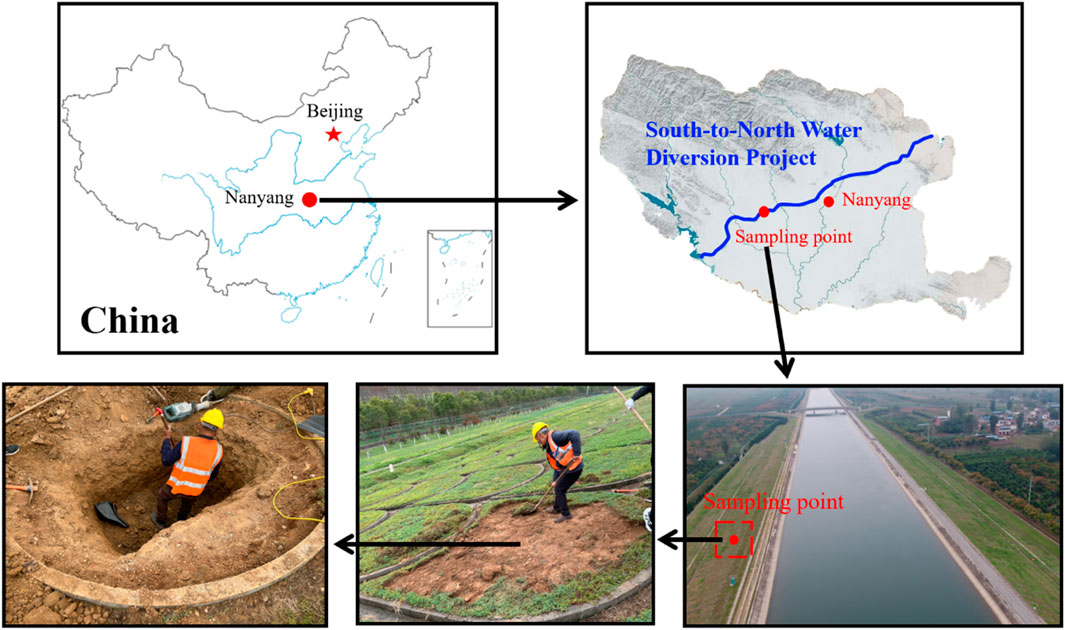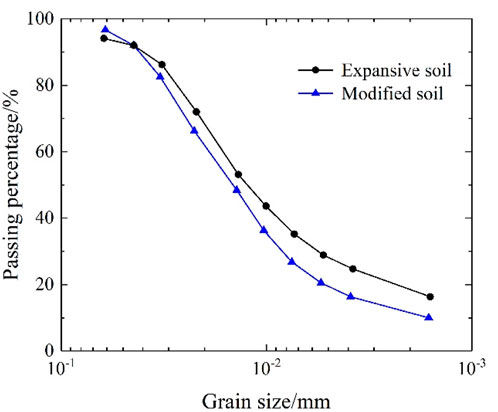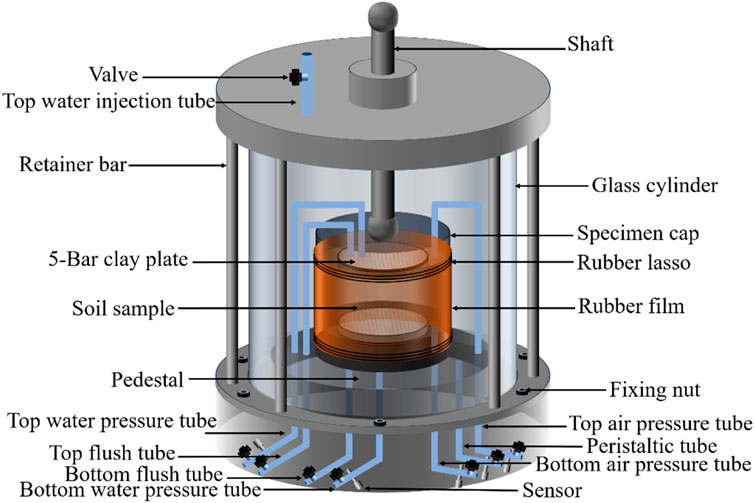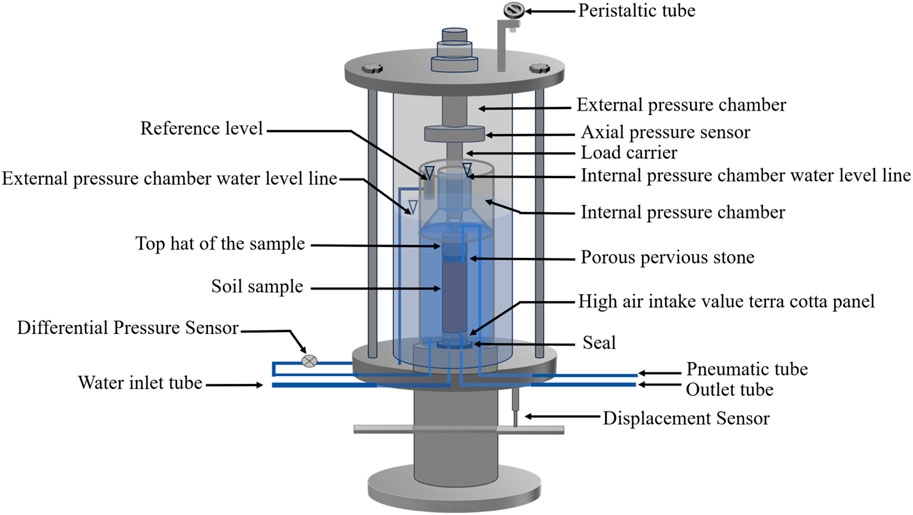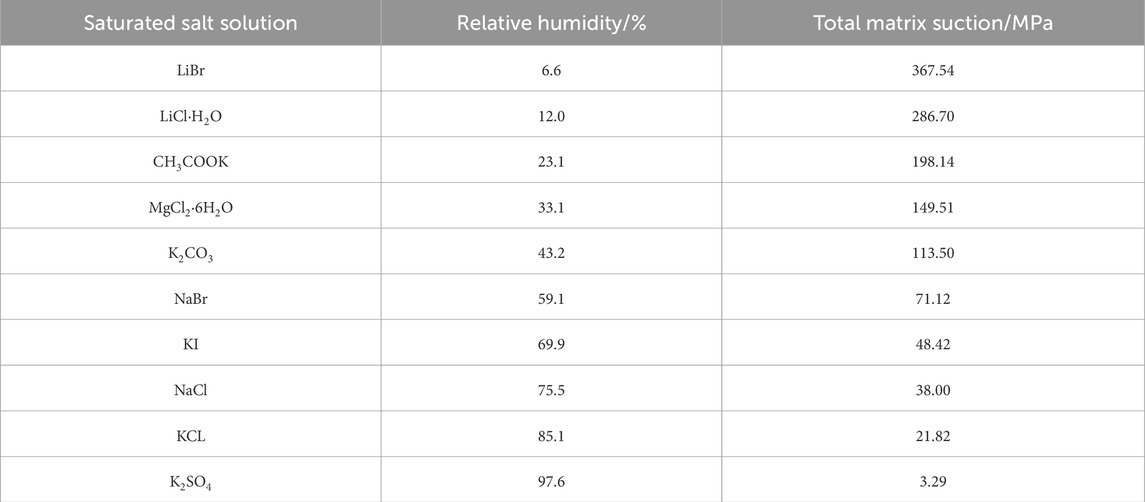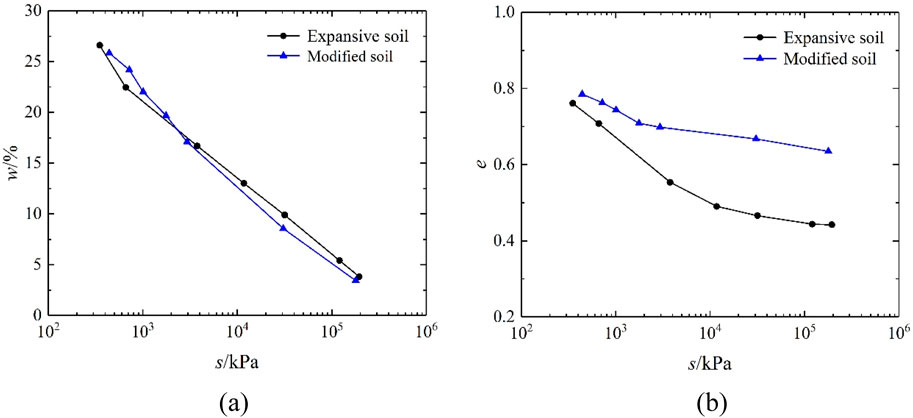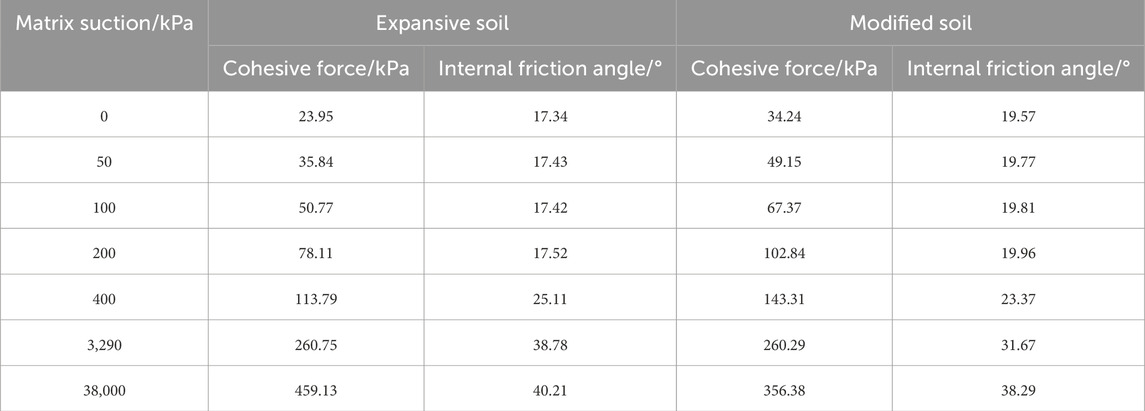- College of Geosciences and Engineering, North China University of Water Resources and Electric Power, Zhengzhou, China
The water-holding and strength characteristics of unsaturated expansive soil and modified soil in a high-fill canal embankment along the central line of the South-to-North Water Diversion Project were investigated using a pressure plate apparatus and a GDS unsaturated triaxial test system. The soil-water characteristic curves (SWCCs) of expansive soil and modified soil were obtained by curve-fitting the results of water-holding characteristic tests, thereby revealing the distinctions in water-holding characteristics of the two soil types. The laws governing the effects of matrix suction on the stress-strain relationships and shear strength of the two soil types were explored through unsaturated triaxial drainage shear tests. According to the test results: (1) The moisture content and void ratio of each soil type decreased gradually with the increase in matrix suction, although the void ratio of modified soil decreased at a slower rate than that of expansive soil. (2) Matrix suction induced a transition from strain hardening to strain softening; (3) The shear strength of both soils increases with the matrix suction and confining pressure, with the increment of expansive soil greater than that of modified soil. Notably, the influence of confining pressure became progressively more significant with increasing matrix suction for both soils; (4) The cohesion and internal friction angle of expansive soil and modified soil increases with the matrix suction, with 200 kPa as the critical point of increasing rate; (5) The expansive soil differs from modified soil in cohesion and internal friction angle under different matrix suctions, with matrix suction of 400 kPa as the critical point. (6) The matrix suction thresholds of 200 kPa and 400 kPa can serve as references for engineering design and construction, as well as seepage prevention and slope reinforcement. This study provides technical parameters and theoretical support for the design, construction, and long-term stability of embankments on the expansive soil in the South-to-North Water Transfer Project site.
1 Introduction
The South-to-North Water Diversion Project is the largest hydraulic diversion project in the world. The project spans China’s four major river basins and more than a dozen provinces (cities), encompassing a multitude of complex geological environments. Notably, the center line of the South-to-North Water Diversion Project comprises approximately 386.8 km of channels that pass through expansive soil areas (Office of the South-to-North Water Diversion Project Construction Committee, State Council, PRC, 2016). Expansive soil and modified soil located along the canal slope are generally unsaturated soils, whose mechanical properties are closely related to moisture content (Yan et al., 2023; Liang et al., 2023; Lei et al., 2023). The matrix suction of shallow soils constantly fluctuates with seasonal dry-wet cycles, which affects their water-holding characteristics and shear strength and consequently compromises the stability of high-fill canal embankments (Jones and Holtz, 1973; Gromko, 1974). To evaluate the effect of water on the stability of unsaturated canal embankments, it is necessary to first identify the variation patterns of the water-holding characteristics and shear strength of unsaturated canal embankment soils in relation to moisture content.
The soil-water characteristic curve (SWCC) serves as a basis for investigating the strength, permeability, and constitutive relationships of unsaturated soils (Fredlund and Rahardjo, 1993; Tuller et al., 2004; Alnmr et al., 2024). Lu and Khorshidi (1999) studied the soil-water characteristics of bentonite and kaolin under high matrix suction and detected notable hysteresis in the former case. Wijaya and Leong (2016); Li et al. (2014) proposed fitting equations for simulating bimodal SWCCs based on the physical interpretations of SWCCs. Cai et al. (2020) conducted tests on the water-holding characteristic of red clay found in Guilin within a wide range of matrix suction by combining the axis-translation technique, the filter paper method, and the salt solution vapor balance method. Satyanaga and Rahardjo (2019) carried out a series of hydraulic tests on a mixture of sandy soil and kaolin. Lu (2016) categorized pore water in unsaturated soils into capillary water and adsorbed water, proposing fitting equations for SWCCs within the complete range of matrix suction. Ma et al. (2024) examined the SWCC of loess and predicted its moisture desorption curve using the particle gradation theory and the fractal theory. Haeri et al. (2019) tested the water-holding capacity of soils with varying lime doses and found that adding lime significantly improved their water-holding characteristics. Li et al. (2020) conducted a case study utilizing silty clay from the Loess Plateau to investigate the effects of soil shrinkage and dry density on the measurement process of its SWCC using a high-speed refrigerated centrifuge. They contended that soil shrinkage led to shrinkage of the soil pore structure and that the effect of soil shrinkage on water-holding capacity was consistent with the effect of increased dry density. Pham et al. (2023) developed a new soil transfer function using seven machine-learning models and one unsaturated soil database, which was employed to estimate SWCCs.
The key to solving problems related to the shear strength of unsaturated soils depends on a reasonable consideration of the effect of matrix suction or saturation on shear strength (Fredlund et al., 1996; Hamid and Miller, 2009; Abd et al., 2020). Researchers, both domestically and internationally, have conducted numerous significant studies on the mechanical properties of unsaturated soils. Zhao et al. (2013) conducted triaxial tests on gap-graded coarse-grained soil with a low range of matrix suction and found that its stress-strain curve may be divided into four distinct stages. Guo et al. (2016) examined the effects of various sample preparation methods on the stress-strain relationships of unsaturated soils through triaxial tests. Zheng et al. (2020) investigated the strength and deformation characteristics of unsaturated soils using a triaxial testing apparatus for local deformation measurement. Zhang et al. (2020) examined the stress-strain relationship and deformation of expansive soil that has a wide range of matrix suction using the vapor balance method and a triaxial apparatus. Yates and Russell (2022) conducted triaxial shear tests on unsaturated loess collected from Akaroa, New Zealand, and found that the peak deviatoric stress of its stress-strain curve gradually increased with the increase in matrix suction. Chen et al. (2024) probed into the hydromechanical behavior of unsaturated kaolin mixtures using a series of triaxial tests controlled by matrix suction. Xing et al. (2019) established the relationship curves between moisture content and matrix suction/coefficient of earth pressure obtained using laboratory tests conducted on unsaturated loess. Wu et al. (2020) carried out rate-controlled undrained triaxial tests on remolded unsaturated soils to explore their hydromechanical behavior under different matrix suction and strain rates. Due to the limitations of available apparatuses, triaxial tests conducted on unsaturated soils are mostly restricted within the matrix suction range of ≤500 kPa (Gao et al., 2019; Blatz et al., 2002), resulting in a scarcity of studies on triaxial tests performed at high matrix suction.
The above findings advance the understanding of unsaturated soil mechanics. While most studies have focused on the common unsaturated soil, scant attention has been paid to the unsaturated expansive soil and/or modified soil in major water infrastructure projects like the South-to-North Water Transfer Project. Furthermore, conducting experiments measuring the unsaturated soil behavior under various matrix suctions is time consuming, leading to predominant focus on low matrix suction (<500 kPa) in existing studies given the technical challenges of high-suction testing apparatus (Blatz et al., 2002; Zhao et al., 2013; Gao et al., 2019). This constraint has resulted in limited research in the water retention and strength characteristics across broad matrix suction range. In this paper, the variation of water content with matrix suction for the expansive soil and modified soil sampled from the South-to-North Water Transfer Project site was precisely measured, and then the triaxial shear tests were conducted to obtain the stress-strain curves under different matrix suctions and confining pressures. Subsequently, the influence of matrix suction and confining pressure on the shear strength and deformation patterns in both soil types was discussed, and the discrepancy between expansive soil and modified soil in the water retention and soil strength was analyzed. This paper not only provide technical guidance for the South-to-North Water Transfer Project but also advances the application of unsaturated soil mechanics theory to the special soil problems by means of new measured data and theoretical analysis.
2 Test overview
2.1 Testing materials and apparatuses
The testing materials consisted of expansive soil and modified soil, sourced from a high-fill canal embankment located in the Nanyang section of the middle line of the South-to-North Water Diversion Project (Figure 1). Expansive soil was extracted from a depth of 1.6 m, whereas modified soil was prepared using expansive soil taken from a depth of 1.0 m by adding cement at a mass proportion of 3%. The soil samples collected from the site were promptly placed into a plastic bag for sealed storage and transported to the laboratory to measure their natural moisture content, dry density, and other indicators. The fundamental physical property indicators are provided in Table 1, the mineral composition is shown in Table 2. The particle sizes of expansive soil and modified soil were measured following the sieving method and the densitometer method. Their particle gradation accumulation curves are shown in Figure 2. According to the classification of soils in building codes, the expansive soil samples analyzed in this study were identified as weakly expansive soil based on a comprehensive consideration of indicators such as free expansion rate and liquid-plastic limit.
The water-holding characteristics of expansive soil and modified soil samples were assessed using a combination of the pressure plate method and the saturated salt solution method. The pressure plate apparatus (Figure 3) manufactured by Soil Moisture Equipment Corp. (United States) was utilized. The apparatus consists primarily of a metal pressure vessel and a ceramic plate with a saturated high air-entry value of 15 bar. The apparatus has a measuring range of 0–1.5 MPa. The apparatus used for the saturated salt solution method consisted of a closed drying vessel, which was used in combination with saturated salt solutions of corresponding matrix suction. The measuring range of the apparatus is 3–368 MPa.
A GDS triaxial apparatus was used for conducting matrix suction-controlled triaxial tests on unsaturated soils (Figure 4). The deformation of samples was calculated from the pressure difference in the water level of the inner pressure chamber, using the double-pressure chamber method. The change in matrix suction during the test process was measured using a back pressure controller.
2.2 Test scheme
2.2.1 Sample preparation
The samples used for testing water-holding characteristics were all remolded and prepared using a standard foil sampler with a diameter of 61.8 mm and a height of 20 mm. The retrieved soil samples were dried and pulverized and subsequently filtered through a 0.5 mm standard sieve, followed by the addition of water until the target moisture content was reached. The moisture content and dry density of expansive soil were 18% and 1.62 g/cm3, and those of modified soil were 22% and 1.52 g/cm3, respectively. An appropriate amount of loose soil was weighed and added to the standard foil sampler, and the sample was prepared in a single instance using the method of static pressing via a jack. The procedure for sample preparation of remoulded soil is as follows: Firstly, place the jack centrally on the baseplate of reaction frame. Then, place the top plate on the piston rod of jack. After that, place the sample mold containing specimen and compression column onto the jack piston. Apply a static pressure of 500 kPa to slowly raise the jack, pressing the exposed compaction column into the mold until it is flattened. Maintain the pressure for 5 min after flattening to ensure uniform compaction, achieving the target dry density and s consistency required for testing. The prepared sample was saturated in a vacuum saturator before use.
Compacted samples were used for triaxial tests. The first step involved filtering the soil collected from the site through a 0.5 mm sieve, and then moisture content and dry density were adjusted. The moisture content and dry density of expansive soil were 18% and 1.62 g/cm3, while the modified soil exhibited values of 22% and 1.52 g/cm3, respectively. The mold of the triaxial test samples was 38 mm in diameter and 76 mm in height. The evenly distributed soil was compacted into four layers. Each layer was roughened upon reaching the controlled height to ensure a uniform dry density.
2.2.2 Test scheme
The pressure plate method involved measuring or controlling matrix suction using the axis-translation technique. First, the saturated sample was placed in the pressure plate apparatus, followed by the application of a specific matrix suction. After the matrix suction was balanced, the volume and mass of the sample were measured. The sample was then placed back into the pressure plate apparatus, and the next level of matrix suction was applied until all levels of matrix suction were applied. The specific matrix suction paths are shown in Table 3. In contrast, the saturated salt solution method involved measuring matrix suction using the closed drying vessel and saturated salt solutions of corresponding matrix suction. The relative humidity value of each saturated salt solution selected in this study and the corresponding matrix suction are shown in Table 4. The matrix suction measurement involved placing the saturated (dried) samples into closed vessels containing saturated salt solutions of corresponding matrix suction. After the matrix suction was balanced, the samples were taken out to measure their volume and mass.
The initial samples of expansive soil and modified soil used in triaxial shear tests were in an identical state. The prepared triaxial test samples were loaded into the pressure chambers, followed by the performance of matrix suction balance, consolidation balance, and triaxial shear in sequence according to the test scheme. Triaxial tests were conducted at matrix suction levels of 0, 50, 100, 200, 400, 3,290, and 38,000 kPa and net confining pressure levels of 50, 80, and 110 kPa, respectively. The saturated salt solution method was adopted for high-matrix suction samples, while the axis-translation technique was used for low-matrix suction samples. Following the balancing of matrix suction, each net confining pressure was applied for consolidation under equal confining pressure and equal matrix suction conditions. The shear test was carried out following consolidation balance, with shear strain maintained at 0.006%/min during the test. Shear ended when axial strain reached 18%. The criteria for assigning values to shear strength can be outlined as follows: If the peak strength is observed within the shear range, the peak strength will be taken as the shear strength under this confining pressure level. Otherwise, the strength value corresponding to the strain of 15% will be considered as the shear strength under this confining pressure level.
3 Test results and analysis
3.1 SWCC analysis
Figures 5a,b shows the SWCCs of expansive soil and modified soil, obtained through integration of the pressure plate method and the saturated salt solution method. The test results indicate that the water content (w) and void ratio (e) of expansive and modified soil decrease greatly with increasing matrix suction in a nonlinear way. When the matrix suction is less than 1000 kPa, the water content and void ratio of expansive soil decreases moderately; whereas a sharp decline is observed once the matrix suction surpasses 1,000 kPa. Since modified soil was prepared from a mixture of expansive soil and cement, the addition of cement produced differences in SWCCs between the two types of soil. As a result of increased matrix suction, the void ratio of modified soil declined at a slower rate than that of expansive soil. This is because the hydration of the cement added into expansive soil changed the soil microstructure, resulting in structural differences between the two types of soil. A flat period occurred prior to matrix suction reaching the air-entry value, during which no significant change in the moisture content was observed in either expansive soil or modified soil. After the matrix suction reached the air-entry value, each soil type exhibited a significant decrease in moisture content. When matrix suction exceeded 1,000 kPa (after reaching the air-entry value), the drainage of large pores became the dominant factor in the decline of moisture content. In addition, as can be seen from Figure 5a, once matrix suction reached 105 kPa, the SWCCs of the two soil types were almost identical. This suggests that, at specific moisture content, the addition of cement barely influenced the variation trend of the SWCC of expansive soil.
3.2 SWCC parameter fitting
To quantitatively evaluate the SWCCs of expansive soil and modified soil, the equation proposed by Van G. and Th M (Van and Th, 1980). (hereinafter referred to as “the Van Genuchten equation”) was utilized to establish the relationship between moisture content and matrix suction for expansive soil and modified soil within the full range of matrix suction.
The relationship between moisture content and matrix suction in the Van Genuchten equation is expressed by Formula 1:
Where
Figure 6 shows the SWCCs of expansive soil and modified soil across the full range of matrix suction, which were curve-fitted using the Van Genuchten equation. It can be seen from Figure 6 that moisture content presented a nonlinear variation pattern with the increase in matrix suction. At a low matrix suction, the moisture content of expansive soil and modified soil declined slowly; conversely, at a high matrix suction, the moisture content of both soils dropped rapidly, presenting an almost linear pattern.
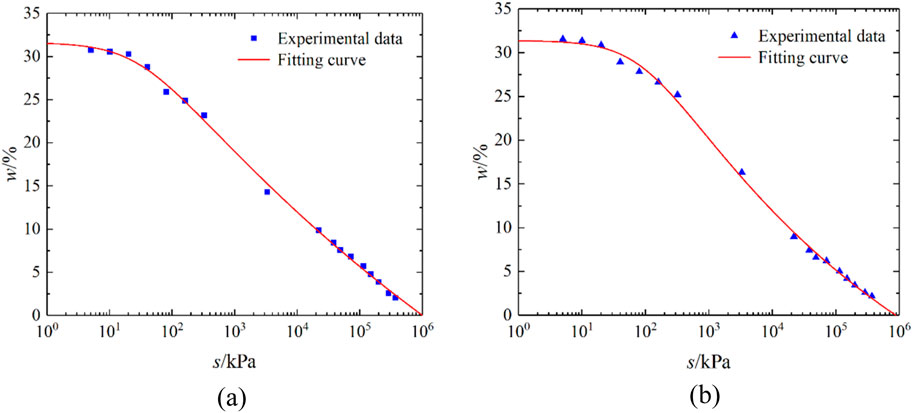
Figure 6. Soil-water characteristic curve fitted by VG model. (a) Expansive soil. (b) Modified soil.
Table 5 shows the fitting parameters of the Van Genuchten equation for both expansive soil and modified soil. It can be seen from the table that expansive soil and modified soil each have a goodness-of-fit of >0.99, indicating a desirable fitting effect. The parameters in the fitting curves of expansive soil and modified soil were comparatively analyzed based on the existing conceptual studies on the Van Genuchten model. The parameter a was negatively correlated with the air-entry value of the SWCC, implying that the larger the air-entry value, the smaller the value of a. It can be seen from Table 5 that the air-entry value of expansive soil was smaller than that of modified soil. This study involved the preparation of modified soil through the incorporation of a certain amount of cement into expansive soil. This modification significantly altered the soil microstructure, resulting in an increased air-entry value and a decreased value of a for modified soil. Table 5 also reveals the effect of the addition of cement on parameter m. In the Van Genuchten model, parameter m characterizes the distribution of soil pores; specifically, a more uniform soil pore size will result in a larger value of the parameter m. The parameter m of modified soil was larger than that of expansive soil, mainly due to the addition of cement, which gradually filled the loose large pores between soil particles with the products of cement hydration, resulting in the closure of large pores into multiple small holes. As a result, the uniformity of the size of soil pores was improved. The parameter n of modified soil exceeded that of expansive soil. The magnitude of parameter n reflects the overall symmetry of soil SWCCs, that is, the larger the value of n, the lower the symmetry of the soil. Furthermore, the smaller capillary pores in the soil meant a stronger water-holding capacity. Therefore, compared with expansive soil, modified soil exhibited a stronger water-holding capacity due to the addition of cement.
3.3 Stress-strain curves
The results of triaxial tests on unsaturated expansive soil and modified soil under different net confining pressures revealed the effect of matrix suction on the stress-strain curves of the soil samples, as shown in Figures 7, 8, respectively. It can be seen from the test results that the stress-strain curves of the two soil types under different matrix suction presented the same variation pattern, characterized as hardening and softening types, respectively. The stress-strain curves of the triaxial test samples of the two soil types varied in form across different matrix suction and confining pressures.
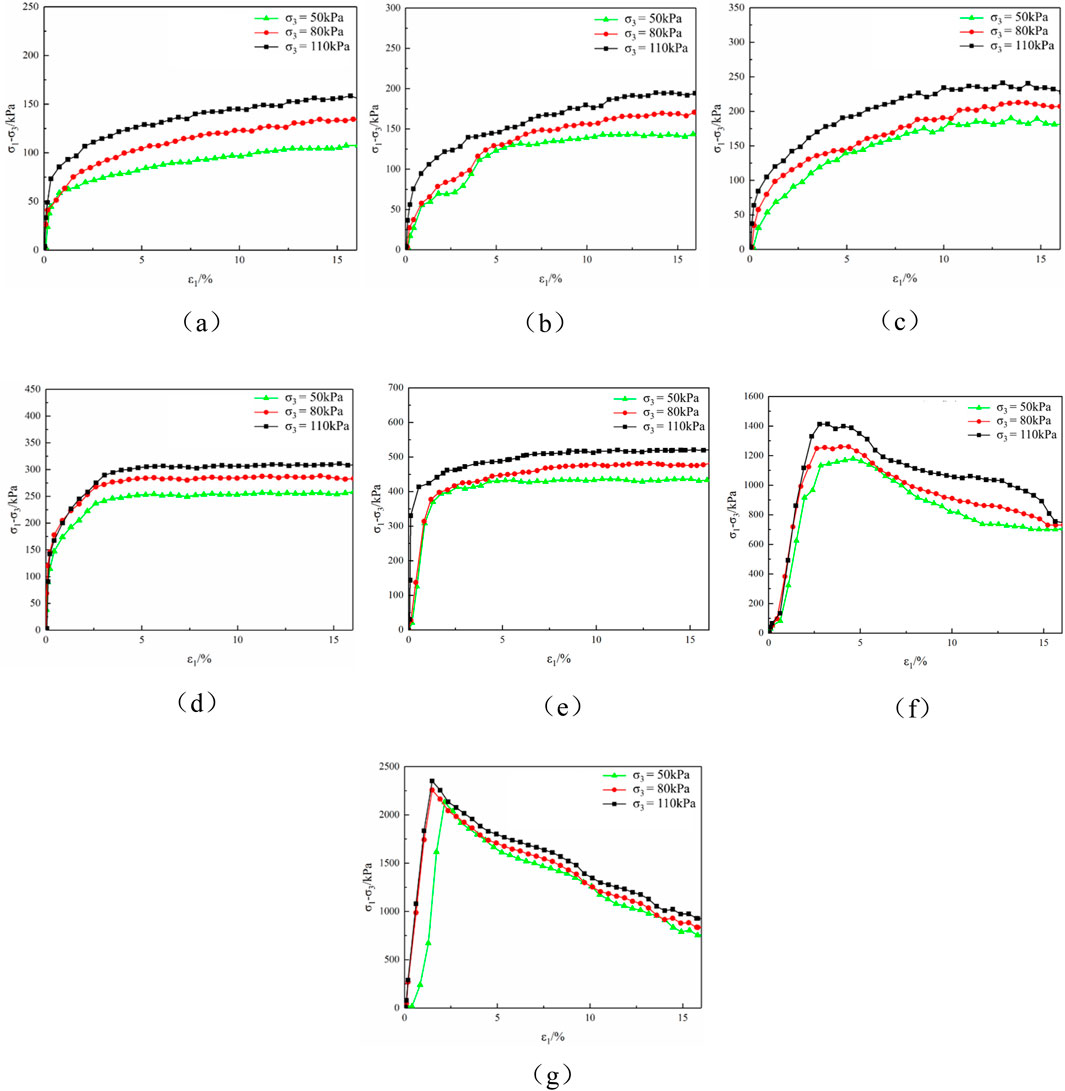
Figure 7. Stress strain curves of expansive soil under different suction forces. (a) s = 0 kPa. (b) s = 50 kPa. (c) s = 100 kPa. (d) s = 200 kPa. (e) s = 400 kPa. (f) s = 3,290 kPa. (g) s = 38,000 kPa.
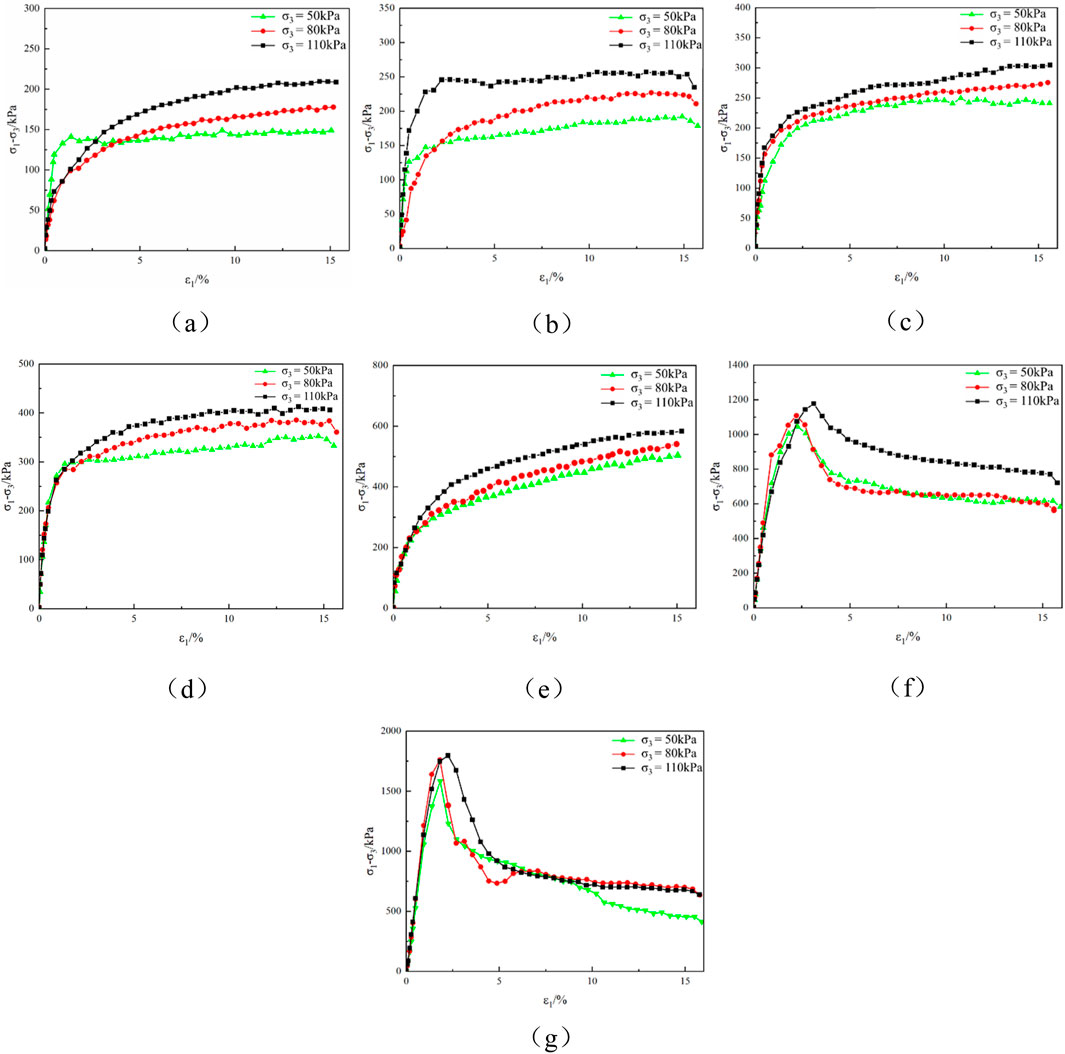
Figure 8. Stress strain curves of modified soil under different suction forces. (a) s = 0 kPa. (b) s = 50 kPa. (c) s = 100 kPa. (d) s = 200 kPa. (e) s = 400 kPa. (f) s = 3290 kPa. (g) s = 38000 kPa.
Under a low soil matrix suction (s < 3.29 MPa), the stress-strain curves for both soil types exhibited strain-hardening behavior. During the initial stage of shear, stress increased rapidly with the increase in strain, and the principal stress difference presented a linear elastic variation pattern. However, at the middle stage of shear, the growth rate of stress gradually declined. At the end of the shear, the growth rate of stress gradually flattened out. In contrast, under a high soil matrix suction (s ≥ 3.29 MPa), the stress-strain curves of both soils showed a distinct peak and were characterized by strain-softening behavior. Under low matrix suction conditions, the soil exhibits strain hardening due to a relatively high void ratio and low effective stress, where sliding friction dominates between particles. During shearing, the volume decreases, contributing to this hardening behavior. As the matrix suction increases, the void ratio decreases, leading to higher effective stress and enhanced frictional resistance and interlocking forces among soil particles. In the initial shearing stage, the soil can sustain higher loads with stress increasing proportionally to strain, thus maintaining hardening characteristics. However, as the strain further increase, the internal soil structure is gradually damaged, accompanied by a rise in void ratio, thereby exhibiting strain softening behavior. With the increase in axial strain, stress increased rapidly, resulting in failure of soil samples and loss of structural strength, in which case stress peaked. In most cases, the soil sample failed at the axial deformation of 1.2%–1.5%.
Comparing the stress-strain curves of expansive soil and modified soil under different matrix suction reveals that, while both types exhibit similar hardening or softening characteristics with the increase in matrix suction, their variation trends differed. For instance, at matrix suction of 3.80 MPa, the stress-strain curves of both soil types were the strain-softening type, however, there were discrepancies in their variation trends after attaining the stress peak. This implied that, after reaching the stress peak, the strain of expansive soil decreased at a nearly consistent rate with the increase in strain and its stress-strain curve changed approximately linearly. In contrast, the stress-strain curve of modified soil initially declined before gradually stabilizing with the increase in strain. This could be due to the addition of cement into modified soil, which engaged in a hydration reaction with soil and changed the microstructure and mechanical properties of soil. Compared to expansive soil, modified soil showed a more stable softening behavior as indicated by its stress-strain curve.
The test results further show that confining pressure also significantly affected the stress-strain curves of expansive soil and modified soil. At the same soil matrix suction, the peak shear strength of the two soil types gradually increased with the rise of confining pressure. This is because confining pressure constrained the sample laterally, which limited the deformation of the sample and strengthened the cohesion between soil particles, causing shear strength to increase.
3.4 Shear strength
The variations of shear strength of the expansive soil and modified soil with matrix suction under different confining pressures are shown in Figure 8, indicating that the shear strength is greatly affected by matrix suction and confining pressure. The shear strength increases nonlinearly with matrix suction and confining pressure. Under the same confining pressure, the shear strength of expansive soil increases more rapidly than that of modified soil as the matrix suction rises. The shear strength of both soils increases slowly when the matrix suction is ≤200 kPa, while it increases remarkably when the matrix suction >200 kPa.
It can also be seen from Figure 9 that, under the same matrix suction, the shear strength of both expansive soil and modified soil gradually increased with the rise of confining pressure. As the matrix suction was increased, the effects of confining pressure on the shear strength of expansive soil and modified soil became more pronounced. When matrix suction was ≤200 kPa, minor variations in shear strength were observed between the two soil types under different confining pressures and the same matrix suction. When matrix suction was >200 kPa, there were significant differences in shear strength between the two soil types under different confining pressures. This can be explained as follows: Under low confining pressure, the soil was slightly compacted. Furthermore, despite the occurrence of soil deformation, the skeletal structure of the soil at this point location exhibited minimal change relative to its previous state, resulting in a low shear strength value of soil. As the confining pressure was increased, the skeletal structure of the soil changed greatly, leading to a more compact arrangement of soil particles and a larger shear strength value.
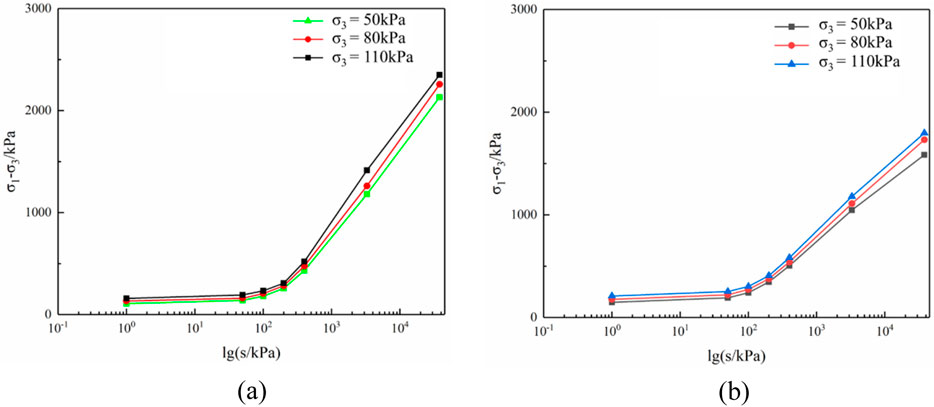
Figure 9. Relationship curve between shear strength and suction force. (a) Expansive soil. (b) Modified soil.
The matrix suction affects the interaction between soil particles by altering the moisture distribution within the soil mass. As the matrix suction increases, the effective stress increases, thereby enhancing friction and particle interlocking forces, which consequently leads to an improvement in soil shear strength. The confining pressure acting laterally to restrain specimen deformation, compacts the soil particles into a denser arrangement and strengthens interparticle bonds, further augmenting the shear strength. The combined effect of these mechanisms results in a progressive increase in soil shear strength with both matrix suction and confining pressure.
3.5 Shear strength parameters
In triaxial tests, the net mean stress is expressed as p = q/3+σ3; while the deviatoric stress is defined as q = σ1—σ3. The stress states qf and pf upon sample failure can be obtained through triaxial testing. The qf and pf values of the sample under different confining pressures and the same matrix suction can be substituted into Formula 2:
where ξ denotes the intercept of the straight line; M denotes the slope of the straight line. The relationships of internal friction angle φ and cohesive force c with intercept ξ and slope M are shown in Formulas 3, 4, respectively:
The shear strength parameters of expansive soil and modified soil are shown in Table 6. The relationships between shear strength parameters and matrix suction are shown in Figure 10. The comparison between the shear strength parameters of expansive soil and modified soil indicated that, under a low matrix suction (s ≤ 400 kPa), the cohesive force and internal friction angle of modified soil were greater than those of expansive soil, respectively. Conversely, under a high matrix suction (s > 400 kPa), the cohesive force and internal friction angle of modified soil were smaller than those of expansive soil, respectively.
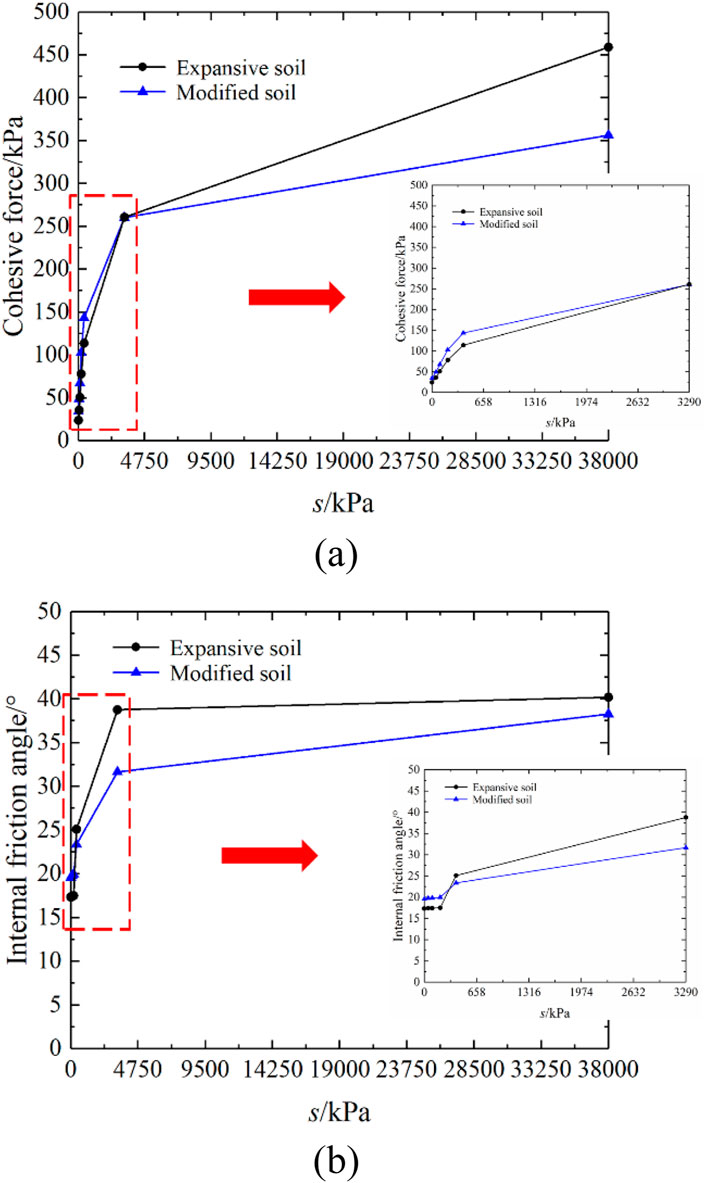
Figure 10. Relationship between shear strength parameters and suction force. (a) Cohesion. (b) Angle of internal friction.
The test results indicate that as matrix suction increased, the variation characteristics of cohesive force and internal friction angle were not completely consistent. The cohesive forces of expansive soil and modified soil showed a nonlinear increase as matrix suction increased. When matrix suction was ≤200 kPa, the cohesive forces of expansive soil and modified soil increased slightly with the increase in matrix suction. On the other hand, when matrix suction was >200 kPa, the cohesive forces of expansive soil and modified soil increased significantly with the increase in matrix suction. In contrast, the internal friction angles of expansive soil and modified soil relatively remained unchanged at a matrix suction of ≤200 kPa, but began to gradually increase when matrix suction exceeded 200 kPa. Triaxial shear tests indicated that, for both soil types, the sensitivity of cohesive force to variations in matrix suction was significantly higher than that of internal friction angle.
The above analysis reveals that the matrix suction thresholds of 200 kPa and 400 kPa play critical roles in governing soil structure evolution and moisture characteristic variations.
When matrix suction is ≤200 kPa, the sliding friction predominates during soil failure due to partial water lubrication and minimal soil structure alteration. Thus the shear strength parameters increase slowly. At matrix suction >200 kPa, progressive water losses occurs, thinning the membrane formed by weakly adsorbed water between soil particles. Therefore, larger aggregate structures form due to the reduction in lubrication between soil particles, and then greater friction should be overcome to motivate the relative dislocation between aggregate structures. Hence, the shear strength parameters increase rapidly once the matrix suction exceeds 200 kPa.
When matrix suction reaches 400 kPa, the water losses continuously, and the water film among soil particles thins steadily, accompanied by a reduced void ratio and enhanced particle interlocking. Consequently, both sliding friction and interlocking friction jointly resist the soil failure, dramatically altering the shear strength parameters relationship between expansive and modified soil. At matrix suction <400 kPa, modified soil exhibit higher shear strength parameters than expansive soils. This is because the soil voids are filled with the hydration products formed by the complete hydrolysis and hydration reactions between water and cementitious minerals on the particle surfaces of modified soil and thus the soil structure becomes denser. At matrix suction >400 kPa, the low water content activates three key mechanisms in expansive soils: matrix suction-enhanced clay crystallization, natural fabric preservation, and mineralogical reactivity. In contrast modified soil experience cementation degradation due to the decreasing matrix suction sensitivity of cementation structure. Therefore, expansive soils surpass modified soils in both shear strength parameters.
Existing research mostly focuses on the matrix suction thresholds of single soil types and often stops at confirming the existence of thresholds. In contrast, this study conducts a comparative analysis of unsaturated expansive soils and modified soils in the South-to-North Water Diversion Project, revealing the dual threshold phenomenon (200 kPa and 400 kPa) accompanied by the evolution of soil microstructure, changes in mechanical properties, and the variation patterns of void ratio and water retention characteristics under these thresholds. The research results provide a more comprehensive and in-depth basis for further understanding the mechanical behavior of unsaturated soils under different matrix suction conditions.
The identified matrix suction thresholds (200 kPa and 400 kPa) hold critical engineering significance for large-scale hydraulic infrastructure like the South-to-North Water Diversion Project, where channel stability directly impacts operational safety and long-term sustainability. The matrix suction thresholds of 200 kPa and 400 kPa can serve as references for engineering design and construction, as well as seepage prevention and slope reinforcement.
4 Discussion
The stress-strain curves of unsaturated expansive soil and modified soil exhibited similar variation patterns under varying net confining pressures under the effect of matrix suction, albeit with differing degrees of influence. The degree of effect of matrix suction on the stress-strain curves of expansive soil and modified soil was affected by the confining pressure level. Under the effect of the same equilibrium matrix suction, the stress-strain curve of soil in the coordinate system increased in height with the rise of confining pressure, but without any change in shape. Therefore, for the same type of soil, confining pressure did not affect the shape of the stress-strain curve but rather affected its height distribution in the coordinate system.
The shear strength of the soil did not increase uniformly with the increase in matrix suction. When matrix suction increased from 200 kPa to 38,000 kPa, the shear strength of remolded expansive soil and modified soil increased significantly; however, the rate of increase in shear strength of soil was non-uniform. Shear strength increased as matrix suction increased, although at a gradually reduced rate. This phenomenon can be attributed to the extremely low moisture content of soil in the residual state, the low moisture content in soil pores, and the inability to transfer matrix suction between soil particles. This indicated that, despite a substantial increase in matrix suction, shear strength would not increase significantly.
Within the considered range of matrix suction, the cohesive forces and internal friction angles of unsaturated remolded expansive soil and modified soil showed significantly different variation characteristics in relation to changes in matrix suction. At a low matrix suction, cohesive force increased gradually, while the internal friction angle exhibited minimal variation. The contribution of matrix suction to shear strength occurred mainly via the action of cohesive force, with variations in matrix suction mainly affecting the cohesive force of soil. Test data indicate that variations in matrix suction greatly affect the strength and stability of unsaturated rock masses in geotechnical engineering practice. The matrix suction angle φb remained constant under a low matrix suction, but decreased nonlinearly with the increase in matrix suction, approaching a stable value under a high matrix suction (greater than the air-entry value (us-uw)b). This behavior reflects the nonlinearity of the strength of unsaturated soil, highlighting the dual effect of a high matrix suction.
Since modified soil was prepared by adding cement at a mass proportion of 3% to expansive soil at a depth of 1.0 m, the addition of cement resulted in differences in shear strength, cohesive force, and internal friction angle of expansive soil and modified soil under different matrix suction. At low matrix suction, the moisture content of the soils was high. The cement minerals on the surface of the cement particles in modified soil underwent full hydrolysis and hydration reactions with the moisture in the soil, resulting in a denser soil structure. Consequently, the shear strength, cohesive force, and internal friction angle of modified soil were greater than those of expansive soil, respectively. In contrast, at a high matrix suction, the moisture content of the soils was low, and the addition of cement affected the adhesive force between soil particles to some degree, resulting in a minor reduction in the shear strength of modified soil compared to that of expansive soil. Consequently, the shear strength, cohesive force, and internal friction angle of expansive soil were greater than those of modified soil, respectively.
From a microscopic perspective, distinct particle size distributions between expansive soil and cement-modified soil lead to differences in pore structure and interparticle contact modes. The expansive soil typically contain a higher proportion of fine particles, which affect the friction and cohesion to some extent. While the modified soil undergo physicochemical reactions between cement hydration products and soil particles; these reactions not only fill void spaces but also alter surface properties of particles, thereby modifying bonding mechanisms. For instance, hydration-generated cementitious materials form interparticle bridges, significantly enhancing soil cohesion.
Under low matrix suction, high water content in soil mass enhanced cement hydration promotes robust bonding, resulting in higher cohesion and internal friction angle in modified soils compared to expansive soils. As the matrix suction increases, the water content decreases gradually, and the moisture state between soil particles changes. At this point, the interaction forces between soil particles also undergo changes. Under high matrix suction, despite the persistence of hydration-induced cementation, the soil shrinkage caused by water loss compacts the particles making frictional forces the dominant factor. In expansive soil, the enhancement of interlocking and friction is more remarkably; whereas in modified soil, hydration products restrict particle mobility to some extent, resulting in a smaller increase in internal friction angle compared to expansive soil under high matrix suction. Therefore, both cohesion and internal friction angle of modified soil become lower than those of expansive soil under high matrix suction.
In contrast to previous studies, this research closely aligns with the practical requirements of South-to-North Water Transfer Project. The experimental validity is strengthened by using in-situ sampled soils collected from the project site combined with field-mimicking testing protocols, which collectively ensure an accurate characterization of the mechanical behavior in both expansive soils and modified soil. The results provides targeted technical references for similar large-scale geotechnical projects.
There are discrepancies between the testing conditions and site setting. In-site soil is subjected to complex stress state, and factors like groundwater seepage, which are difficult to fully simulate in the lab. In terms of testing conditions, the limited size of triaxial test samples may not completely represent the in-site soil behavior. Additionally, the laboratory’s constant temperature and humidity differ from actual field conditions. In the further, the in-site measurement data may be applied to verify the conclusions in this paper.
5 Practical engineering recommendations
The experimental results on the unsaturated expansive soil and modified soil obtained in this paper offer significant guidance for engineering design and construction of the South-to-North Water Transfer Project. The modified soil has better water retention capacity than expansive soil, and hence the modified soil should be prioritized as the impermeable material in channel anti-seepage designs when the local soil has high matrix suction. For example, in sections of the South-to-North Water Transfer Project where channels pass through expansive soil regions with shallow groundwater tables, significant variations in matrix suction may occur. In such cases, applying chemically modified soil can effectively reduce water migration, lower the risk of channel seepage, and ensure water transfer efficiency and channel stability.
In the stability design of embankment slope, the effect of the matrix suction and confining pressure on shear strength of soil must be thoroughly considered. The shear strength of both expansive and modified increases with matrix suction and confining pressure, with a significant enhancement observed when matrix suction exceeds 200 kPa. Therefore, in channel slope design, an appropriately designed drainage system can be can be implemented to maintain high matrix suction levels, thereby improving the soil’s shear strength and reducing the risk of slope instability. In addition, the increase in confining pressure is another effective strategy to enhance shear strength. For example, the soil retaining structures such as retaining wall can be adopted to apply lateral pressure to the soil, thereby increasing confining pressure and improving slope stability.
Regarding engineering management measures, the long-term monitoring of matrix suction in soils near the channels should be strengthened. A real -time monitoring system must be established to track variations in matrix suction. When the measured matrix suction approaches a critical threshold, the immediate reinforcement or drainage measures should be taken.
6 Conclusion
This study examined the water-holding and strength characteristics of unsaturated canal embankment soils in the South-to-North Water Diversion Project. Tests for water-holding characteristics and multi-matrix suction triaxial tests were carried out to measure SWCCs of expansive soil and modified soil. The laws governing the effects of matrix suction on the stress-strain curves, shear strength, and shear strength parameters of expansive and modified soils were explored. This study provides technical parameters and theoretical support for the design, construction, and long-term stability of embankments on the expansive soil in the South-to-North Water Transfer Project site. The main conclusions are as follows:
(1) Matrix suction greatly influenced the moisture content and void ratio of expansive soil and modified soil. With the gradual increase in matrix suction, the moisture content and void ratio of each type of soil presented a nonlinear decreasing pattern. The void ratio of modified soil decreased at a lower rate compared to that of expansive soil. However, after matrix suction reached 105 kPa, the SWCCs of the two soil types were almost identical. The Van Genuchten equation produced desirable fitting effects on the SWCCs of both expansive soil and modified soil. The parameters m and n of modified soil exceeded those of expansive soil, whereas the parameter a of expansive soil surpassed that of modified soil, indicating a superior water-holding capacity of modified soil.
(2) The stress-strain curves of expansive soil and modified soil were significantly affected by matrix suction and confining pressure. Under low matrix suction, the curves show strain-hardening behavior under and demonstrate a gradual transition to strain-softening as matrix suction increases (s ≥ 3.29 MPa). As confining pressure increased, the peak shear strength of the two soils gradually increased. Following the attainment of the stress peak, the stress-strain curves of expansive soil and modified soil showed distinct variation patterns. It can be inferred that, after stress peaking, the stress-strain curve of expansive soil exhibited linear progression, while that of modified soil first declined before gradually stabilizing with the increase in strain.
(3) The laws governing the effects of matrix suction and confining pressure on the shear strength of expansive soil and modified soil were similar. Under the same confining pressure, the shear strength of each soil type showed a nonlinear increase with the increase in matrix suction. When matrix suction was ≤200 kPa, the shear strength of expansive soil and modified soil increased slightly with the increase in matrix suction. On the other hand, when matrix suction was >200 kPa, the shear strength of the two soils increased significantly with the increase in matrix suction. The increase in the shear strength of expansive soil with matrix suction was more pronounced than that of modified soil. Under the same matrix suction, the shear strength of expansive soil and modified soil gradually increased as the confining pressure was increased. Whereas, when the matrix suction was increased, the effects of confining pressure on the shear strength of expansive soil and modified soil gradually enhanced.
(4) The cohesive force and internal friction angle of each type of soil were significantly affected by matrix suction, although their variation characteristics with matrix suction differed. When matrix suction was ≤200 kPa, the cohesive forces of expansive soil and modified soil increased slightly with the increase in matrix. On the other hand, when matrix suction was >200 kPa, the cohesive forces of expansive soil and modified soil increased significantly with the increase in matrix. In contrast, the internal friction angles of expansive soil and modified soil essentially remained unchanged at a matrix suction of ≤200 kPa, but began to gradually increase when matrix suction surpassed 200 kPa.
(5) The cement hydration resulted in significant variations in the shear strength of expansive soil and modified soil under different matrix suctions. At a low matrix suction (s ≤ 400 kPa), the cohesive force and internal friction angle of modified soil exceeded those of expansive soil, respectively. Under a high matrix suction (s > 400 kPa), the cohesive force and internal friction angle of modified soil were smaller than those of expansive soil, respectively. The test results revealed the strength characteristics of expansive soil found in canal embankments under specific environmental conditions, providing scientific references for the design and management of canal embankment projects in water-abundant areas.
(6) The identified matrix suction thresholds (200 kPa and 400 kPa) hold critical engineering significance for large-scale hydraulic infrastructure like the South-to-North Water Diversion Project, where channel stability directly impacts operational safety and long-term sustainability. The matrix suction thresholds of 200 kPa and 400 kPa can serve as references for engineering design and construction, as well as seepage prevention and slope reinforcement.
Data availability statement
The original contributions presented in the study are included in the article/supplementary material, further inquiries can be directed to the corresponding author.
Author contributions
DW: Conceptualization, Formal Analysis, Methodology, Resources, Supervision, Writing – review and editing. CW: Data curation, Formal Analysis, Investigation, Validation, Writing – original draft. ZW: Investigation, Validation, Visualization, Writing – review and editing.
Funding
The author(s) declare that financial support was received for the research and/or publication of this article. The Open Foundation of Jiangxi Hydraulic Safety Engineering Technology Research Centre (Grant No. 2023SKSG07), and the Jiangxi Provincial Department of Water Resources Foundation (Grant No. 202324YBKT04).
Conflict of interest
The authors declare that the research was conducted in the absence of any commercial or financial relationships that could be construed as a potential conflict of interest.
Generative AI statement
The authors declare that no Generative AI was used in the creation of this manuscript.
Publisher’s note
All claims expressed in this article are solely those of the authors and do not necessarily represent those of their affiliated organizations, or those of the publisher, the editors and the reviewers. Any product that may be evaluated in this article, or claim that may be made by its manufacturer, is not guaranteed or endorsed by the publisher.
References
Abd, I. A., Fattah, M. Y., and Mekkiyah, H. (2020). Relationship between the matric suction and the shear strength in unsaturated soil. Case Stud. Constr. Mater. 13, e00441. doi:10.1016/j.cscm.2020.e00441
Alnmr, A., Alzawi, M. O., Ray, R., Abdullah, S., and Ibraheem, J. (2024). Experimental investigation of the soil - water characteristic curves (SWCC) of expansive soil: effects of sand content, initial saturation, and initial dry unit weight. Water 16 (5), 627. doi:10.3390/w16050627
Blatz, J. A., Graham, J., and Chandler, N. A. (2022). Influence of suction on the strength and stiffness of compacted sand–bentonite. Can. Geotech. J. 39 (5), 1005–1015. doi:10.1139/t02-056
Cai, G., Zhou, A., Liu, Y., Xu, R., and Zhao, C. (2020). Soil water retention behavior and microstructure evolution of lateritic soil in the suction range of 0 - 286.7MPa. Acta Geotech. 15 (12), 3327–3341. doi:10.1007/s11440-020-01011-w
Chen, K., He, X., Liang, F., and Sheng, D. (2024). Critical state behaviour of an unsaturated kaolin mixture. Eng. Geol. 338, 107606. doi:10.1016/j.enggeo.2024.107606
Fredlund, D. G., and Rahardjo, H. (1993). Soil mechanics for unsaturated soils. John Wiley and Sons, Inc.
Fredlund, D. G., Xing, A., Fredlund, M. D., and Barbour, S. L. (1996). The relationship of the unsaturated soil shear strength to the soil - water characteristic curve. Can. Geotech. J. 33 (3), 440–448. doi:10.1139/t96-065
Gao, Y., Sun, D., and Zhou, A. (2016). Hydromechanical behaviour of unsaturated soil with different specimen preparations. Can. Geotech. J. 53 (6), 909–917. doi:10.1139/cgj-2015-0381
Gao, Y., Sun, D., Zhu, Z., and Xu, Y. (2019). Hydromechanical behavior of unsaturated soil with different initial densities over a wide suction range. Acta Geotech. 14 (2), 417–428. doi:10.1007/s11440-018-0662-5
Gromko, G. J. (1974). Review of expansive soils. J. Geotech. Eng. Div. 100 (6), 667–687. doi:10.1061/ajgeb6.0000059
Haeri, S. M., Garakani, A. A., Roohparvar, H. R., Desai, C. S., Seyed Ghafouri, S. M. H., and Salemi Kouchesfahani, K. (2019). Testing and constitutive modeling of lime - stabilized collapsible loess. I: experimental investigations. Int. J. Geomech. 19 (4), 04019006. doi:10.1061/(ASCE)GM.1943-5622.0001364
Hamid, T. B., and Miller, G. A. (2009). Shear strength of unsaturated soil interfaces. Can. Geotech. J. 46 (5), 595–606. doi:10.1139/T09-002
Jones, D. E., and Holtz, W. G. (1973). Expansive soils - the hidden disaster. Civ. Eng. 43 (8), 49–51. doi:10.12691/jgg-6-3-3
Lei, K. C., Ma, F. S., Chen, B. B., Luo, Y., Cui, W. J., Zhao, L., et al. (2023). Effects of South - to - north Water diversion project on groundwater and land subsidence in beijin, China. Bull. Eng. Geol. Environ. 82 (1), 1–24. doi:10.1007/s10064-022-03021-2
Li, L., Li, X., Wang, L., Hong, B., Shi, J., and Sun, J. (2020). The effects of soil shrinkage during centrifuge tests on SWCC and soil microstructure measurements. Bull. Eng. Geol. Environ. 79, 3879–3895. doi:10.1007/s10064-020-01786-y
Li, X., Li, J. H., and Zhang, L. M. (2014). Predicting bimodal soil - water characteristic curves and permeability functions using physically based parameters. Comput. Geotech. 57 (4), 85–96. doi:10.1016/j.compgeo.2014.01.004
Liang, H., Zhang, D., Wang, W., Yu, S., and Wang, H. (2023). Quantifying future water and energy security in the source area of the western route of China’s South-to-North water diversion project within the context of climatic and societal changes. J. Hydrol. Reg. Stud. 47, 101443. doi:10.1016/j.ejrh.2023.101443
Lu, N. (2016). Generalized soil water retention equation for adsorption and capillarity. J. Geotech. Geoenviron. Eng. 142 (10), 04016051. doi:10.1061/(ASCE)GT.1943-5606.0001524
Lu, N., and Khorshidi, M. (1999). Mechanisms for soil - water retention and hysteresis at high suction range. J. Geotech. Geoenviron. Eng. 141 (8), 04015032. doi:10.1061/(ASCE)GT.1943-5606.0001325
Ma, J., Zeng, R., Bian, S., Meng, X., Zhang, Z., and Khalid, Z. (2024). Prediction of hysteretic soil and water characteristic curve of loess based on multifractal theory and improved physical statistics. J. Hydrol. 632, 130898. doi:10.1016/j.jhydrol.2024.130898
Office of the South-to-North Water Diversion Project Construction Committee, State Council, PRC (2016). The south - to - north water diversion project. Engineering 2 (3), 265–267. doi:10.1016/J.ENG.2016.03.022
Pham, K., Kim, D., Le, C. V., and Won, J. (2023). Machine learning - based pedotransfer functions to predict soil water characteristics curves. Transp. Geotech. 42, 101052. doi:10.1016/j.trgeo.2023.101052
Satyanaga, A., and Rahardjo, H. (2019). Unsaturated shear strength of soil with bimodal soil - water characteristic curve. Géotechnique 69 (9), 828–832. doi:10.1680/jgeot.17.P.108
Tuller, M., Or, D., and Hillel, D. (2004). Retention of water in soil and the soil water characteristic curve. Encycl. Soils Environ. 4, 278–289.
Van, G., and Th, M. (1980). A closed - form equation for predicting the hydraulic conductivity of unsaturated soils. Soil Sci. Soc. Am. J. 44 (5), 892–898. doi:10.2136/sssaj1980.03615995004400050002x
Wijaya, M., and Leong, E. C. (2016). Equation for unimodal and bimodal soil - water characteristic curves. Soils Found. 56 (2), 291–300. doi:10.1016/j.sandf.2016.02.011
Wu, S. S., Zhou, A. N., Shen, S. L., and Kodikara, J. (2020). Influence of different strain rates on hydro - mechanical behaviour of reconstituted unsaturated soil. Acta Geotech. 15 (12), 3415–3431. doi:10.1007/s11440-020-01026-3
Xing, Y., Gao, D., Jin, S., Zhang, A., and Guo, M. (2019). Study on mechanical behaviors of unsaturated loess in terms of moistening level. KSCE J. Civ. Eng. 23 (3), 1055–1063. doi:10.1007/s12205-019-0848-x
Yan, H. L., Lin, Y. Q., Chen, Q. W., Zhang, J. Y., He, S. F., Feng, T., et al. (2023). A review of the eco-environmental impacts of the South-to-North water diversion: implications for interbasin water transfers. Engineering 30, 161–169. doi:10.1016/j.eng.2023.05.012
Yates, K., and Russell, A. (2022). The unsaturated characteristics of natural loess in slopes, New Zealand. Géotechnique 73 (10), 871–884. doi:10.1680/jgeot.21.00042
Zhang, J., Niu, G., Li, X., and Sun, D. (2020). Hydro - mechanical behavior of expansive soils with different dry densities over a wide suction range. Acta Geotech. 15 (1), 265–278. doi:10.1007/s11440-019-00874-y
Zhao, H. F., Zhang, L. M., and Fredlund, D. G. (2013). Bimodal shear - strength behavior of unsaturated coarse - grained soils. J. Geotech. Geoenviron. Eng. 139 (12), 2070–2081. doi:10.1061/(ASCE)GT.1943-5606.0000937
Keywords: high-fill canal embankment, unsaturated soil, shear behavior, soil-water characteristic curve (SWCC), matrix suction
Citation: Wang D, Wang C and Wang Z (2025) An experimental study of the water-holding and strength characteristics of unsaturated canal embankment soils in the South-to-North water diversion project. Front. Earth Sci. 13:1558910. doi: 10.3389/feart.2025.1558910
Received: 11 January 2025; Accepted: 21 April 2025;
Published: 02 May 2025.
Edited by:
Chong Xu, Ministry of Emergency Management, ChinaReviewed by:
Paramita Bhattacharya, Indian Institute of Technology Kharagpur, IndiaLiang Jinxi, China University of Mining and Technology, China
Anshuang Su, Heilongjiang Province Hydraulic Research Institute, China
Copyright © 2025 Wang, Wang and Wang. This is an open-access article distributed under the terms of the Creative Commons Attribution License (CC BY). The use, distribution or reproduction in other forums is permitted, provided the original author(s) and the copyright owner(s) are credited and that the original publication in this journal is cited, in accordance with accepted academic practice. No use, distribution or reproduction is permitted which does not comply with these terms.
*Correspondence: Dubo Wang, bmN3dXdhbmdAMTI2LmNvbQ==
 Dubo Wang
Dubo Wang Chuang Wang
Chuang Wang